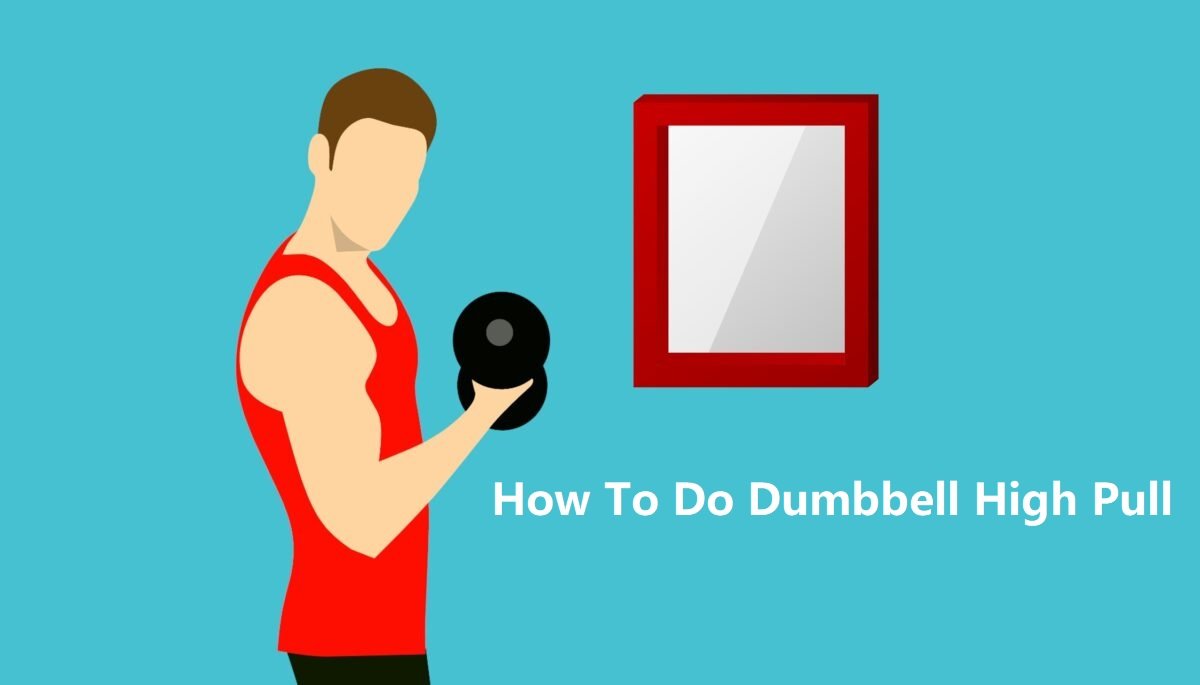How to do Dumbbell High Pull – Benefits & Precautions 2025

The dumbbell high pull is an effective upper-body exercise that works for several muscle groups simultaneously. It’s a great addition to any strength training routine. In this comprehensive guide, we will cover proper form, muscle groups worked, benefits, precautions, and variations of the dumbbell high pull exercise.
Disclaimer: This article provides general information and serves as a guide. Engaging in any new fitness activity or exercise involves a potential risk of injury. Consult with a qualified professional before beginning a new exercise program and using proper technique.
What is the Dumbbell High Pull?
The dumbbell high pull is a compound exercise that works the back, shoulders, and arm muscles. It is considered a “pull” exercise as you are pulling the weights up towards your shoulders. The movement starts with the weights at arm’s length in front of your thighs. You then bend your knees slightly and “explode” upwards, pulling the dumbbells up along the front of your body until they reach shoulder height. Then you reverse the movement to return to the starting position.
Muscles Worked
The dumbbell high pull is a full-body exercise that targets the following muscle groups:
- Upper back – The pulling motion heavily works the muscles of the upper back, like the trapezius, rhomboids, rear shoulders, and latissimus dorsi.
- Shoulders – Your front and side deltoid muscles are activated to lift the weights overhead. The external rotators also work to stabilize your shoulder joints.
- Biceps – The biceps contract powerfully as you lift and curl the dumbbells up towards the shoulders.
- Forearms – A strong grip is needed to keep hold of the dumbbells during the explosive pulling motion. The forearm muscles are worked isometrically.
- Glutes and hamstrings – These large lower body muscles contract to help drive you upwards against gravity.
- Quadriceps – The quads are worked eccentrically to control the lowering portion of the movement.
- Core – The abdominal muscles contract to stabilize your spine during this powerful full-body exercise.
As you can see, the dumbbell high pull works for all the major muscle groups in the upper and lower body. No muscle is isolated during this exercise.
Proper Form and Technique
- Proper form is crucial when performing dumbbell high pulls to maximize results and avoid injury. Follow these technique tips:
- Stand with your feet about hip-width apart in an athletic stance. Keep your knees slightly bent. Engage your core.
- Grip the dumbbells so your palms are facing your thighs. Use an overhand grip. Hands should be positioned just outside your hips.
- Pull your shoulders down and back so they do not rise. Maintain this neutral shoulder position throughout the move.
- Initiate the move by explosively driving through your heels, extending your hips as you stand tall. Generate power from your glutes, hamstrings, and quads. Do not overly use your lower back.
- As you stand up straight, keep your elbows above the dumbbells and pull the weights straight up close along the front of your body.
- Raise the dumbbells until they reach shoulder height. Your elbows should drive high, with the weights ending near your shoulders.
- Squeeze your back muscles at the top of the movement. Do not lean excessively backward.
- Reverse the movement with control, maintaining a neutral spine as you lower the weights back to the starting position.
- Breathe out as you exert force, pulling the weights up. Inhale as you lower them back down.
Beginner Mistakes
- Those new to the dumbbell high pull should avoid these common form mistakes:
- Not generating enough power from the lower body – Your legs and hips should drive the movement. Don’t just use your arms and back.
- Overarching the lower back during the pull – Keep your back flat and neck neutral. Do not hyper-extend your spine.
- Pulling the weights behind your body – They should track the front close to your center of gravity.
- Lifting the elbows out to the side – Keep them above your hands, driving straight up for full back contraction.
- Not pulling high enough – Raise the weights to shoulder height for a full range of motion.
- Returning slowly to the starting position – Control the weights as you lower them, but don’t pause at the bottom.
- Mastering proper high pull technique takes practice. Begin with lighter dumbbells until the movement pattern feels natural.
Exercise Benefits
When executed with proper form, the dumbbell high pull offers many benefits:
- Builds upper back strength – The pulling motion heavily targets the muscles of the upper back. Over time, this can improve posture.
- Works the shoulders and arms – Pulling heavy loads increases shoulder stability. The biceps are also worked through the upper range of motion.
- Recruits power from the legs – Explosively driving from your lower body utilizes major muscle groups. This helps build whole-body power.
- Increases lifting speed and explosiveness – The fast, powerful motion improves the rate of force production. This carries over to sports and strength gains.
- Elevates heart rate and burns calories – As a total body movement, high pulls are an efficient metabolic and cardio conditioning exercise.
- Challenges core stability – Your abdominal muscles are worked isometrically to keep your spine neutral during the explosive pull.
- Enhances grip strength – Holding heavy dumbbells recruits your forearm and hand muscles isometrically.
The high pull hits all the major muscle groups while also building athletic power and movement skills. It is a useful cross-training exercise for many sports.
Precautions and Safety Tips
- While highly effective when done properly, certain precautions should be kept in mind to maximize safety:
- Use an appropriate weight – Pick a challenging but manageable load you can lift with proper form. Build up slowly over time.
- Maintain a flat back – Do not round overarch your spine during the movement. Keep your core braced.
- Avoid shoulder impingement – Do not let the weights drift too far behind your body as you pull upwards.
- Control the descent – Lower the weights with control to protect your shoulder joints. Do not release them to drop.
- Check your grip – Make sure to grip the dumbbell handles tightly throughout the entire range of motion.
- Know your limits – The high pull requires power, mobility, and technique. Substitute an easier variation if needed.
- Consider wrist wraps – Wearing wraps can allow for a better grip and prevent wrist strain under heavy loads.
- Warm up properly – Prepare your body by foam rolling, dynamic stretching, and doing lighter sets before going heavy.
- Using proper form, starting light, and gradually increasing weight minimizes injury risk so you can benefit from the high pull over the long term.
Exercise Variations
While the traditional high pull has you lifting the dumbbells to shoulder height, there are several variations to consider:
- Hang High Pull – Performs the move holding the dumbbells with arms extended. Works grip strength.
- Power High Pull – Explode upwards and catch the weights overhead in a partial shoulder press. Advanced move.
- Underhand Grip – Upalms-uplms up/neutral grip instead of overhand. Hits the arms and back differently.
- Single Arm – Does the move one arm at a time, allowing a greater range of motion, which creates a challenge.
- Cable High Pull – Uses a cable machine. Allows constant tension through the movement range.
- Band High Pull – Attaches exercise bands for accommodating resistance. Great for mobility work.
Modify the high pull to target different muscles, enhance the challenge, and keep your body guessing by incorporating different variations into your workouts.
Workout Programming
- Here are some tips for effectively programming dumbbell high pulls into your training:
- Place near the start of your workout after warming up when you are fresh.
- Use heavier loads and lower reps when focusing on strength/power (3-5 reps per set).
- Use moderate loads and higher reps for muscular endurance (8-12 reps per set).
- Allow at least 1 day of rest between training the same muscle groups to avoid overtraining.
- Use as an explosive power exercise along with plyometrics or medicine ball throws.
- Pair with pressing and squatting moves for a well-rounded strength workout.
- Vary your grip and stance width to change emphasis and prevent overuse.
- Increase weight and decrease reps over time as you grow stronger to continually challenge your body.
Properly incorporating high pulls into your current regimen can add muscle-building intensity and athletic power. Just be sure to allow for adequate recovery between sessions.
Also Read: Sensitive Eyes to Wind: Symptoms, Effects & Cure
Sample Beginner Workout
Here is a beginner-level dumbbell high-pull workout:
Warm Up:
- Jumping jacks x 20 reps
- Arm circles x 10 reps forward/backward
- Bodyweight squats x 10 reps
- Band pull-aparts x 15 reps
Workout:
- Dumbbell high pull x 10 reps
- Goblet squat x 10 reps
- Push-ups x 10 reps
- Plank hold x 30 seconds
- Perform 3 rounds total with 60-90 seconds rest between rounds. Use a challenging weight that allows you to complete all reps with proper form. Work your way up to heavier weights over time.
Cool Down:
- Foam roll lats, mid back, quads, hamstrings
- Child’s pose or cat/cow pose hold for 30 seconds
- This combines an upper-body power move with a lower-body strength move for a well-balanced beginner routine. Execute with proper technique and increase the challenge over time.
FAQs
What is the main difference between an upright row and a high pull?
The upright row pulls the weights straight up to chest level with elbows driving out to the sides. The high pull brings the weights up higher (around shoulder level) with elbows above the hands finishing near the shoulders.
Should my wrists be straight or bent during the high pull?
Keep your wrists straight and rigid in their natural and neutral position. Do not overly bend or flex the wrists, as this can limit force transfer.
Can I do a full overhead press at the top of the high pull?
It is best to limit the upper range of motion to around shoulder height. Going into a full overhead press increases injury risk to the shoulders and lower back.
How much weight should I start with as a beginner?
For males,s look to start with 25-40 lb dumbbells. For females, 15-25 lbs is often appropriate to begin with. Make sure you have the mobility, form, and control before using heavier weights.
Is the high pull beneficial for athletes?
Yes, the high pull builds power, explosiveness, grip strength, and whole-body muscle activation, making it extremely applicable for sports performance enhancement. It is often used by strength coaches.
Conclusion
When performed correctly, dumbbell high pulls are a versatile exercise that strengthens your full body, engages fast-twitch muscle fibers, and enhances athletic power production. However, the movement requires proper technique, so take time to master the mechanics and start with an appropriate weight. Include high pulls as part of a structured, progressive program, and you can build an impressive upper body with functional fitness carryover.


